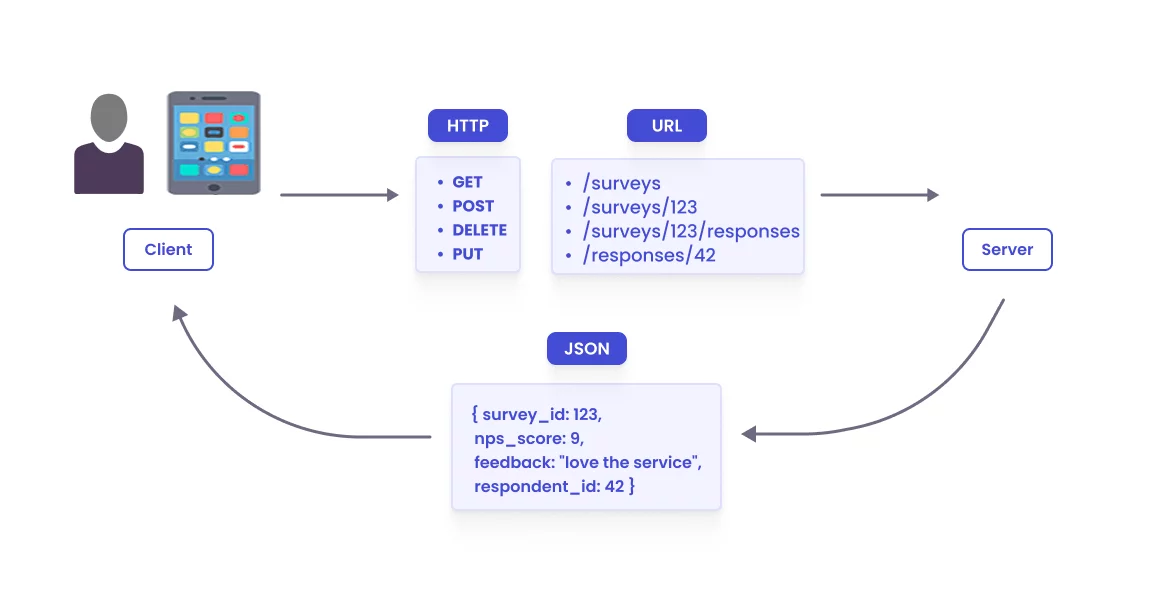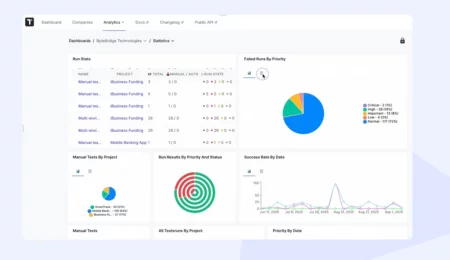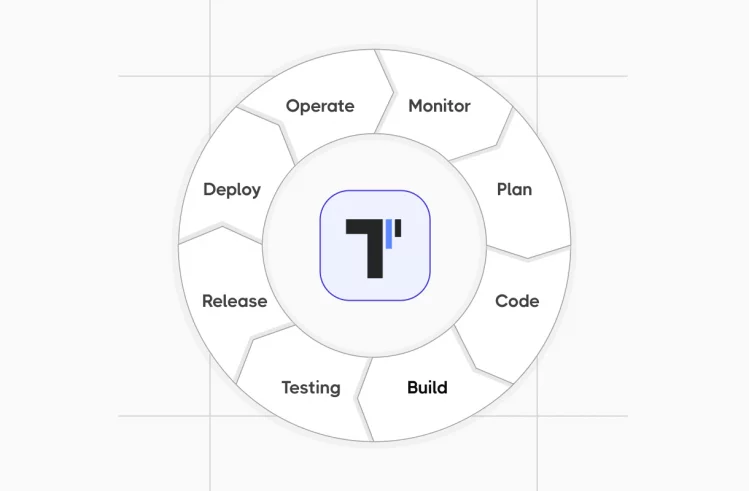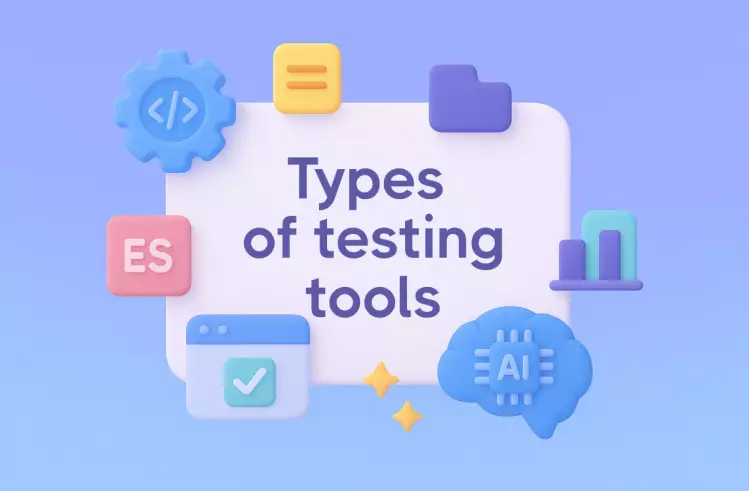In the new era, modern software systems are becoming increasingly interconnected, their backbone is data communication. Web services, REST APIs, and HTTP are the primary technologies used here, as dependable and seamless. QA engineers need to be familiar with these terms and how they work to test APIs well.
🔴 The mentioned terms are not the same and should not be confused!
This article clears up the confusion by exploring the key differences between HTTP and REST APIs, their use cases, and when to use each. Moreover, each subsequent concept is broader than the previous one.
What is HTTP?
HTTP (HyperText Transfer Protocol) is the fundamental Internet protocol, where hypertext documents include hyperlinks that the user can easily access. We use it to send and receive information, such as web pages, images, videos, or API data. In short, when you type a website address into your browser, HTTP is the language your browser uses to ask the server for that page — and then display it for you.

The HTTP protocol has been important since it began. It helped create the World Wide Web we use today. It was first made for simple web pages. Now, it has grown to support more complex duties.
What is HTTP API?
An HTTP API is any API that uses the HTTP protocol for communication between clients (like a web browser or mobile app) and servers. Typically, it uses standard HTTP methods like:
- GET – to retrieve data
- POST – to submit data
- PUT – to update data
- DELETE – to remove data
HTTP APIs are straightforward, flexible, and widely supported. They do not have to follow any specific design pattern or constraints beyond using HTTP to exchange data. The typical format: JSON or XML.
Status Codes
HTTP response status codes indicate whether a specific HTTP request has been completed. Responses are grouped into five classes below, follow the link to know details:
- Informational responses (100 – 199)
- Successful responses (200 – 299)
- Redirection messages (300 – 399)
- Client error responses (400 – 499)
- Server error responses (500 – 599)
What is a REST API?
A REST API (Representational State Transfer) is a specific type of HTTP API that follows a set of architectural principles defined by Roy Fielding in 2000.
It means that a server will respond with the representation of a resource (today, it will most often be an HTML document) and that resource will contain hypermedia links that can be followed to make the state of the system change. Any such request will in turn receive the representation of a resource, and so on.
An important consequence is that the only identifier that needs to be known is the identifier of the first resource requested, and all other identifiers will be discovered. This means that those identifiers can change without the need to inform the client beforehand and that client and server must be inherently loosely coupled.
Core Characteristics REST APIs
REST is not just about using HTTP to move data. It uses all the features of the HTTP protocol, namely the standard HTTP methods to perform CRUD operations (Create, Read, Update, Delete which match GET, POST, PUT, and DELETE operations, which we considered earlier). They allow quick data transfer between systems.
REST is designed to manage the chaos of Internet-scale usage, in a world of millions of users and endless data. To achieve this, it maintains a light and free connection between your app (the client) and the server. REST provides the foundation for meeting the requirements of the Web: extensibility, anarchic scalability, independent deployment of components, large-grain data transfer, and a low entry barrier for content readers, content authors, and developers.
This makes REST ideal for many modern web applications. These applications go from simple mobile apps to complex cloud services, and work with different programming languages and platforms. The program that adheres to the REST architectural constraints is informally described as RESTful.
Normally, a specific API has several endpoints, and each one links to a certain URL. Each request contains all the information needed to process it.
REST API Example:
Imagine a social media platform — it has different types of data (called resources) such as:
/users– represents users of the platform
/posts – represents posts made by users
/comments– represents comments on posts
Typical REST API Endpoints:
GET/users– fetch a list of all usersGET/users/123– get details about a specific user with ID 123POST/posts– create a new postGET /posts/456/comments– extract comments for a post with ID 456DELETE/comments/789– delete a comment with ID 789
As you can see, REST APIs process resources (e.g., users, posts, or products) as the core entities, accessed via unique URLs.
What is JSON?
JavaScript Object Notation (JSON) is a standard text-based format for representing structured data. It is a custom payload that contains a message with the properties and values we want to use to create or update a given resource.
Using tools such as Postman or Insomnia, you can receive a response to your request.
GET/users/123{
"user":{
"id": 123,
"name": "Educative",
"age": 28
}
}Summary
HTTP API and REST APIs are ways for apps to talk over the web using HTTP rules, but do it in diferrent way.
It is like using a specific programming style, such as functional programming, in a language like Python.
Real-World API Examples to compare
- HTTP. It is a simple internet link like a
https://testomat.io/A universal addressing system (think URLs) — is the magic that powers the web. - HTTP API. A weather app’s API might expose a single endpoint like an endpoint
/weather?city=Londonto return data in a custom JSON format. It’s simple, so it may not follow REST principles. - REST API: API REST, with resources like
/{posts}/456/{comments}and standard HTTP methods (GET to retrieve, POST to create). It’s consistent and scalable.
Principles Guiding RESTful API Design
Not all HTTP APIs are REST APIs💡
The API needs to meet the following architectural requirements to be considered a REST API:
Key REST APIs principles:
- Stateless. No client state is stored on the server between requests. Nevertheless, the request must include everything needed to process it.
- Resource-based. Data is organized into resources with unique URIs (e.g., /users/123).
- Standardized methods. Uses HTTP methods (GET, POST, PUT, DELETE) consistently allows developers to build applications more easily.
- Layered system. It means each component interacts only with the next immediate layer. This abstraction supports adding features like caching static assets, proxies, and gateways to reduce response time or the server’s load.
- Scalable. Designed for performance and maintainability in large systems.
- Hypermedia as the Engine of Application State (HATEOAS). This helps clients navigate the available interactions and reduces the need for extra information outside the requests.
REST API principles help create systems that are strong, remain flexible, and work well together. They differ from other types of APIs, which may not be as organized.
REST: More Than HTTP
HTTP is the most common protocol for REST. This happens because it fits well with the above-mentioned REST principles. However, REST is flexible and not only limited to HTTP. RESTful systems can also use other methods, like FTP, if they can share data in a common way, which people sometimes forget when they explain it simply.
REST API Benefits
Let’s figure out how REST APIs enhance web services:
- Simplicity – a major benefit is the API architecture. The use of standard HTTP methods like GET, POST, PUT, and DELETE makes the REST API lightweight for understanding, implementation and maintenance.
- Separation of Concerns – clean separation between client and server logic enhances development. A main part of REST is splitting tasks between the client and the server. This way, they can work separately and be developed on their own as they grow. It makes it easier to scale and helps complex applications run smoothly.
- Statelessness – another important point is that every client request to the server needs to have all the information the server needs to understand and respond. This means the server does not need to remember any session data.
- Scalability – statelessness of REST makes it easier to scale applications and maintain them. They run fast for many users or in areas with low internet speed. RESTful APIs can handle many requests at once without issues.
- Flexibility – works with many types of data formats and can be used across different platforms and languages.
- Performance – caching and lightweight data transfers improve speed and reduce the load on servers. When clients save copies of popular resources, they make fewer requests to the server. This leads to quicker responses and a better experience for users.
- Widespread Adoption – REST API is well-supported by different tools, libraries, and frameworks, making integration straightforward.
It is also important to note that you do not have to strictly adhere to the REST software architectural style in every situation to reap its benefits. Apply REST principles when they are more suitable.
Comparing HTTP API & REST APIs
Let’s compare HTTP and REST APIs. We will discuss the main technical differences between them. These differences provide each API with unique features for various purposes. Developers need to know these differences. This knowledge helps them pick the right type of API for their projects.
We will also focus on the key factors that can affect their performance. Additionally, we will cover the best times to use each option. This comparison will show the strengths and weaknesses of both types of APIs. This way, you can test API of your project best.
| HTTP API | REST API | |
| Protocol | HTTP | HTTP (commonly) |
| Architectural Style | Not strictly defined | REST architectural constraints (client-server, stateless, cacheable, etc.) |
| Data Format | Flexible (JSON, XML, etc.) | Standardized (typically JSON or XML) with request body transformation. |
| State Management | Can be stateful or stateless | Stateless |
| Hypermedia Support | Not inherently supported | Encouraged (HATEOAS) |
| Complexity | Can be simpler to implement | Can be more complex due to REST constraints |
HTTP APIs and REST APIs are both ways of software communication. Because of this, they are good for different situations.
Here are a few important points to consider when choosing between them:
Use Cases and Practical Applications
- REST APIs. These are great for public APIs, complex integrations, and apps that require careful monitoring and error tracking. They are the best option for developing flexible and scalable web services.
Security and Management Features
- Security Options. REST APIs usually feature strong security. They offer mutual TLS authentication, backend certificate checks, and tools like AWS WAF for better protection.
- API Management. REST APIs come with features like API keys, client-specific rate limits, and usage controls. These help to manage and keep track of API use well. HTTP API is a simpler definition and does not include these management tools.
Endpoint and Integration Capabilities
- Endpoint Types. REST APIs offer several choices. They support edge-optimized, regional, and private endpoints. On the other hand, HTTP APIs mainly use regional endpoints.
- Integration Options. REST APIs can use mock integrations. They are also good for scaling microservices. HTTP APIs are effective for private resources with load balancers, but they might not allow mock integrations.
Performance and Cost Trade-offs
- Cost Efficiency. HTTP APIs are often faster and less expensive. This makes them ideal for simple apps and times when quick development is important.
- Scalability and Flexibility. REST APIs perform better in bigger and more complicated systems. They use rest principles, such as not storing state and allowing caching. This supports being modular and growing on their own.
Performance and Scalability Considerations
- HTTP APIs are often faster. This is because they have a simple design and need less work. They are great for apps where speed is very important. Examples include high-frequency trading and real-time data streaming services on the public internet.
- REST APIs might be a little slower. This is because they focus on REST principles, which can lead to some delays. However, as time goes on, the advantages of using REST APIs, such as being easy to scale, often make up for this minor speed issue. They provide a simpler alternative for developers.
- REST APIs do not keep records of past requests. They can use caching to make things work better. This makes their responses quicker. It also helps them manage several requests at the same time. By using an application load balancer, they can share requests among different servers. This way, REST APIs can manage more traffic when necessary.
Conclusion
Web developers need to know the differences between HTTP and REST APIs. HTTP APIs have changed to meet specific needs in modern web development. On the other hand, REST APIs provide rules that improve web services. Both definitions have their own features and some similarities. It’s important to think about their performance and how well they can grow. Choosing the right API architecture will depend on what your project needs. By understanding the key traits of each, you can make a smart choice for your goals. If you want more information or have questions, check our Frequently Asked Questions section.
Get help from our experts to dive deeper into API integration. This can make your web development projects even better.
Choosing between API methodologies requires you to think carefully about what your project needs the most.
Frequently asked questions
What Makes an API RESTful?

An API is called RESTful when it follows REST principles. These are guidelines that help make web services easier to scale and adapt. They also make it simpler for web services to work well with other services.
Can HTTP APIs Support RESTful Principles?

HTTP APIs use HTTP methods. This is similar to RESTful web services and RESTful APIs. However, they do not follow all the rules of REST. A genuine RESTful API does more than just use certain HTTP methods. It also includes all the main ideas of REST architecture.








